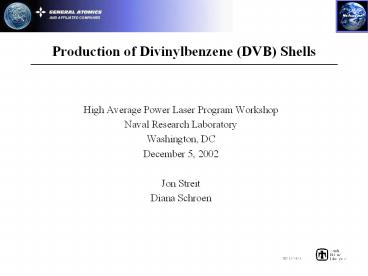Production of Divinylbenzene (DVB) Shells - PowerPoint PPT Presentation
1 / 14
Title:
Production of Divinylbenzene (DVB) Shells
Description:
Refurbished droplet generator to accommodate larger shells ... Created gelled, overcoated beads in a single step. 4 mm Diameter Foam Shell ... – PowerPoint PPT presentation
Number of Views:32
Avg rating:3.0/5.0
Title: Production of Divinylbenzene (DVB) Shells
1
Production of Divinylbenzene (DVB) Shells
- High Average Power Laser Program Workshop
- Naval Research Laboratory
- Washington, DC
- December 5, 2002
- Jon Streit
- Diana Schroen
2
Review
- 4 mm Diameter Foam Shell
- 300 micron DVB Foam Wall
- CH Polymer
- 1 micron Cell Size
- 20 - 100 mg/cc
- 1 micron Carbon Overcoat
- 0.03 micron Metallic Coating
- Refurbished droplet generator to accommodate
larger shells - Polymerized DVB shells 4 mm in diameter at 100
mg/cc - Obtained characterization data for first six
batches of shells - Concentricity primary problem
- Created gelled, overcoated beads in a single step
3
Density, Interfacial Tension, and Agitation
- Work has focused on density matching.
- Density matching helps center the inner and outer
drop, but density is a function of temperature.
If the inner water core of the shell has the same
density at room temperature as the surrounding
organic layer, the densities will not be the same
at the elevated gelling temperature because the
thermal expansion is not the same for the
different solutions. - Influences of interfacial tension and agitation
need to be studied further as will be seen. - M. Takagi, R. Cook, R. Stephens, J. Gibson, S.
Paguio, Decreasing Out-Of-Round in Poly(a-Methyl
Styrene) Mandrels by Increasing Interfacial
Tension, Fusion Technology, Vol. 38, p. 46 July
2000. - T. Norimatsu, Y. Izawa, K. Mima, P. M. Gresho,
Modeling of the Centering Force in a Compound
Emulsion to Make Uniform Plastic Shells for Laser
Fusion Targets, Fusion Technology, Vol. 35, p.
146, March 1999.
4
Initial Density Matching Results in 5 PVA
- Chart represents the calculated room temperature
density difference between the inner water core
and the organic phase compared with the average
measured nonconcentricity percent. - Initial results indicated that the optimal
density difference would occur at about 0.012
g/cc. - Shell characterization provided by GA.
5
Additional Density Matching Results in 5 PVA
- After more data was collected in the 0.010 to
0.012 g/cc range, the trend appeared to be less
clear. Optimum appeared to be about 0.019 g/cc. - A V shape would be expected when the data is
plotted in this manner.
6
Reinterpreted Density Matching Data in 5 PVA
- Examining the results for a greater than 0.015
g/cc density difference should help clarify the
situation. - Other factors to reduce nonconcentricity are
being investigated (temperature, interfacial
tension, agitation).
7
Initial 0.05 PAA Density Matching Results
- PAA has been investigated as a replacement for
PVA. PAA has been shown to increase interfacial
tension leading to decreased out-of-round in the
PAMS shell system. - Initial results in PAA suggest that density
matching may not be the determining
nonconcentricity factor.
8
Temperature Dependence of Density
- Temperature in gelation flask was found to vary
from 65-73 ?C. This causes a fluctuation in the
density match. - A temperature controller
- was obtained to
- minimize temperature
- fluctuations.
- DVB polymerization
- experiments using UV
- initiation performed.
- Polymerization achieved,
- but presently too slow to
- be useful.
9
Agitation
- A cylindrical flask has replaced a pear shaped
flask more uniform agitation. - Centering forces have been shown to be generated
with shell deformation. - Shells travel in an undisturbed circular pattern
when the flask is completely full of solution. - Filling the flask with less solution adds
disruption to shell path.
Bottom view of shell path in full flask
Bottom view of shell path in 2/3 full flask
10
Shell Overcoating Has Begun
The organic phase and internal water phase must
be removed.
The shell is placed in organic solvent
acid chloride.
ORGANIC ACID CHLORIDE
The shell is rinsed with IPA, then liquid CO2.
The CO2 is taken supercritical and vented.
The shell is placed in a reactive aqueous
solution. A wall is built at the interface.
11
Overcoating Characterization
Uncoated Shell
Coated Shell
- Confocal image of shell.
- 900X magnification.
- Image is 100 microns across.
- All features are submicron in depth.
12
Shell Cracking
- Shells do not ship well - 25 broken or cracked
after shipment. - 95 broken or cracked after exchanging to DBP
for characterization (estimates and image from
GA). Handling needs to be minimized. - Cracking less problematic when exchanging into
IPA needs to be monitored.
13
Radiographic Characterization
- X-ray radiograph of shell.
- System is being modified for foam needs
optimizing energy and adding rotation. - System currently has 28 micron resolution.
- Also designing tomographic system with 10 micron
resolution planned for FY04.
14
Future Work
- Determine optimal density matching and its
significance. - Determine advantage of using PVA or PAA system.
- Examine influence of agitation.
- Determine methods to reduce shell cracking.
- Develop x-ray radiography characterization
system. - Develop wet characterization system at Sandia.

